List of Authors
>>About this blog
Recent blog post
|
[Hanes]
June 22, 2018 18:00
Hello. This is a new correspondent, Hanes. 
There is something like a boom in history.
This year, 150 years after the Meiji Restoration, there are a lot of events and tours related to it!
Saigo Takamori, a related person, is also attracting attention, including Taiga drama series.
But at the same time, did you know that Jomon was hot after the tumulus?
"The most beautiful mysteries in the world" and "the origin of beauty in Japan"...
It is called "Jomon" and attracts attention worldwide.
At the Tokyo National Museum, special exhibition's "Jomon: The Beat of 10,000 Years of Beauty" began on July 3.
Also in early July, the movie "People who are addicted to Jomon" will be released.
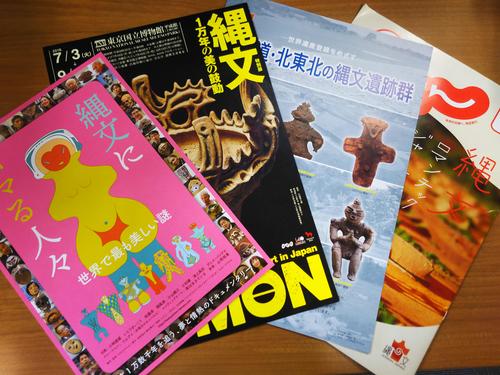
In addition, the Jomon archaeological sites in Hokkaido and northern Tohoku are aiming to be registered as World Heritage.
An unprecedented Jomon boom has arrived, such as a tour of Jomon archeological sites.
Furthermore, "Omprisey Miyake" developed a collection inspired by Jomon pottery decorations and patterns in the fall and winter of 2017.
This spring and summer fashion incorporates clay figurines as motifs.
Some experts say that Jomon pottery and clay figurines are modern designs.
Jomon may have been a gorgeous and attractive era.
This time, we will introduce a talk about clay figurines held at Kouyama Ryusen-do, a long-established antique art museum during the Tokyo Art Antique period, as well as sweets on the theme of Jomon period that can be enjoyed in Chuo-ku and ward around Jomon period.
Talk by Kimiyuki Kawashima, Representative Director, "DOGU - Dogu Various Dogu"
There are parts that are connected to other civilizations, and the daily lives and prayers of the people at that time are reflected.
I was able to learn about the charm of clay figurines that I didn't teach at school.
Here is a brief introduction of the contents of the talk.
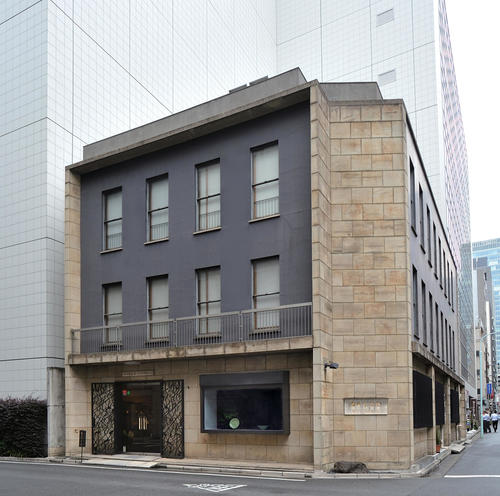
(Image provided by Kouyama Ryusen-do)
■Worldwide!
In the pre-stage of civilization (especially after the late Paleolithic age), earthen and stone doll statues have been found around the world.
The image of a woman excavated from the Dolni Vestnis archeological site in the Czech Republic is shown.
It is very similar to the "Jomon Venus" excavated in Japan.
Similar female images have been found in Germany, Switzerland, and the Indus River basin.
It can be seen that many human groups on earth were wearing such production techniques.
However, the Chinese civilization, which had already made pottery using pigments in 6000 BC, is exception!
It was during the Warring States period between the 5th and 3rd centuries BC that black pottery warriors and warriors began to be made.
This point seems to be unexpectedly blind spots among clay figurines researchers.
The details are expected to be gradually revealed in future studies.
■Reflection of Lifestyle
It is said that the Jomon clay figurines can read the life at that time.
From the beginning to the first half of the year: Because hunting is the main thing, there are many small and simple clay figurines that can be carried around.
Medium-term: The climate is stable and a huge settlement is created, and the number of gorgeous clay figurines with attention to detail increases.
■The motif is a woman
Since ancient times, many idols in the shape of women have been made from prayers for fertility and fertility.
Example: "Squealing clay figurines" (with earthen balls in the abdomen) inspired by a woman who lives.
Clay figurines representing the scene of childbirth (Tangible Cultural Property designated by Yamanashi Prefecture)
However, with the passage of time, the priesthood elements associated with the Gemojin were added.
In the late and late stages, they began to have funeral-related and human-separated elements.
It is a clay figurine that tends to be put together in the Jomon period.
In fact, I was able to know again that the meaning and application are diverse.
Chuo-ku, before and after Jomon period
Chuo-ku has gradually increased landfills since the opening of the prefecture, and flourished.
Therefore, it is no exaggeration to say that there is no previous image.
However, the Tokyo Metropolitan Government White Paper on Buried Cultural Properties (1977) records that there are two shell mounds in Chuo Ward.
Did people already live in the area that was land for a long time before and after the Jomon period?
In a lecture in 1935, Dr. Ryuzo Torii, a leader in prehistoric and anthropology in East Asia, gave a lecture.
It is said that deer bones and flat stone tools from Paleolithic period were excavated from the place where it was Shirakiya at the time.
Unfortunately, the discovery was lost in the Shirakiya fire several years before the lecture.
It seems that there are no photographs or records like this....
No matter how true or false, there is romance.
In 1951, a small woman's human bone of about 20 years old at 120 cm was discovered from the construction site of Mitsui Annex, and the newspaper introduced only to the ancestors of Shimomachi daughter as "Nihonbashi Komachi"!
Dr. Nobuo Naora, who investigated, thought of it as an ancient man from the excavated layer of bones, and named it "Homosapiens / Nihon Basiens".
Another doctor criticized me that he was close to the skulls of the Middle Ages and early modern times, and that he was not an ancient man.
"Nihonbashi Komachi" and "Homosapiens and Nihon Basiens" are unique names, right?
In the end, no Jomon period archeological site has been identified in Chuo-ku.
There was an interesting fact that I didn't expect.
There are many mysteries that have not been elucidated in modern times, and I'm just crazy about it.
And finally, I would like to introduce sweets with the theme of clay figurines.
It is Ginza NAGANO that handles such unique sweets.
The relationship between Nagano and Jomon may not come easily, but it may not be easy to see.
Actually, the famous "Jomon Venus" was excavated at the Tanahata archeological site in Chino City, Nagano Prefecture!

(Image provided by Ginza NAGANO)
The first thing that caught my eye in the corner where products related to Jomon were lined up was that
Not only the shape, but also the acorn flour and the ingredients here are Jomon-like cookies.
I'm looking forward to seeing what it tastes!
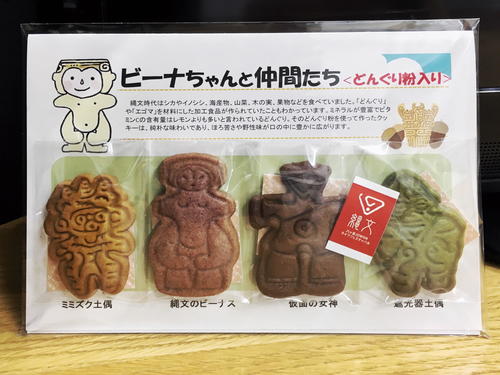
In addition, it is included in an easy-to-carry package that is perfect for gifts.
We also sell three-dimensional Jomon Venus and Masked Goddess Yokan.
Not only Jomon enthusiasts, but also Jomon beginners.
This summer, an antique store, a museum, a movie theater, an antenna shop.
Have you rediscovered the charm of Jomon?
[An antique shop in Chuo-ku that deals with Jomon period relics and clay figurines]
Kouyama Ryusen-do
〒104-0031 2-5-9, Kyobashi, Chuo-ku, Tokyo
Business hours 10:00~18:00
Regular holidays: Sunday and public holidays
http://www.mayuyama.jp/
Go
"Tokyo Art Antique" was held at the time of the event.
It was said that Jomon-related products are not always lined up in stores.
We have a wide range of interesting products, including archeological artifacts.
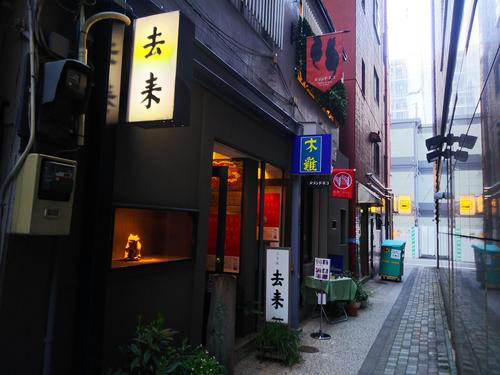
〒1-6-14 Kyobashi, Chuo-ku, Tokyo 104-0031 1st floor of Saeki Building, 1-6-14 Kyobashi, Chuo-ku, Tokyo
Business hours 14:00~18:00
Regular holidays: Sunday, Monday and public holidays
http://www.kyorai-art.com/
[Sweets with Jomon and clay figurines as motifs]
Ginza NAGANO
1F, 2F, 4F, NOCO Building 5-6-5 Ginza, Chuo-ku, Tokyo
Business hours 10:30〜20:00(1F・2F)
Regular holidays: New Year holidays
[Event information about Jomon and clay figurines]
special exhibition "Jomon: The Beat of Beauty of 10,000 Years" (Jomon Exhibition)
More than 10,000 clay figurines from Jomon period were excavated from all over Japan.
Only 5 points have become national treasures! It's a great opportunity to see precious clay figurines.
From July 3 (Tuesday) to September 2 (Sunday), 2018
Heiseikan, Tokyo National Museum (Ueno Park)
http://jomon-kodo.jp/
The movie "People who are addicted to Jomon"
The screening schedule will be announced at a later date.
Theatre Image Forum (Shibuya)
http://www.jomon-hamaru.com/
[References]
Susumu Kitahara, Sumiyoshi Yamamoto (1979) "Tokyo Furusato Bunko 21 History of Chuo-ku", edited by the Society for Furusato in Tokyo, a famous book Publishing.
Shunbu Jubishi, Shotaro Nomura (1984) "The 30,000 Years of Tokyo Talked by Archeological Sites", supervised by Mitsunori Tozawa, Kashiwa Shobo.
MIHO MUSEUM edition (2012) "Togu / Cosmos" Hatori Shoten.
※The photos of the store have been approved by the person in charge.
[yaz]
June 22, 2018 09:00
The city of Tokyo is still growing toward the entrance of Tokyo Bay. Offshore Odaiba, the construction of the landfill outside of the central breakwater is still ongoing, but this project was started in 1977 (1977) and is still in the middle of the project. This project, which Ieyasu started reclaiming land and continues, began in Tsukishima in the Meiji era. In the Edo period, soil generated during the construction of bunkers and rivers on land was discarded and reclaimed, but in the Meiji period, mud generated by dredging the seabed to reclaim land.
Tsukishima No. 1 was born by dredging and stacking underwater mud in the Miosakarai project in 1892 (1892). Next, it stretched elongated offshore to No. 2, No. 3 (current Kachidoki, Toyomi), and No. 4 (current Harumi). At the same time, this mio dred project was also the improvement of the mouth of the Sumida River. For many years, the Sumida River removed the mud brought to the seabed and improved the route.
On the river line of Tsukishima and Tsukuda Island, there were many barges such as horse-drawing boats, daruma boats, and motor boats. Goods transported by cargo ships are collected and distributed on a relatively large ship called large barge, and landed on a transshipmented small barge, transport the river line. From the Taisho era to the Showa era, there were 69 rivers flowing through Tokyo City and its surroundings, and water transportation was convenient for transportation. According to a survey by the water department at the end of 1927, the number of barges engaged in water transport was 11,290, and barge was also a workplace for each band. Its population was 31,036 (20,600 men and 10,436 women), and more than half of them were water residents who did not have a house on land. The barge, a place of work and living, was less than 50 tons at large and less than 10 tons at small. The size of the room to wake up was as small as 2-3 quires. There were three to four family members living here. In order to provide the welfare of these residents, a water hall and a water school (a boarding school built on land) were built, and a water police station in charge of security was set up. The exact number of people in Chuo-ku (= Nihonbashi-ku / Kyobashi-ku) at the time of 1927 is unknown, but the graph shows that it was about 240,000, so water residents alone accounted for more than 10%.
As of February 2018, the population of the Tsukishima district (Tsukishima, Kachidoki, Harumi) is 72,780 and the number of households is 37,443. It accounts for 46% of the population of Chuo-ku (= 157,388). It is no exaggeration to say that the population of Chuo-ku always has at the waterfront.
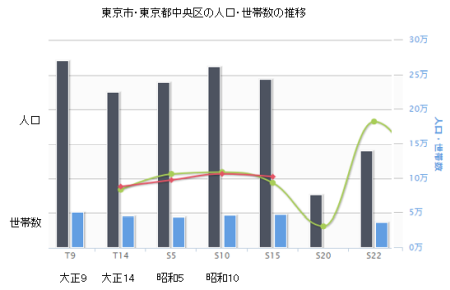
It seems that many water residents did not have a family register, so the actual ratio is expected to have been higher than the above figures.
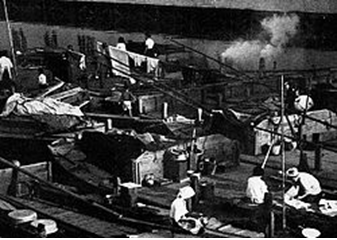 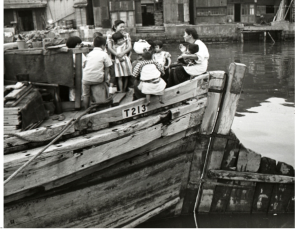
In the latter half of the 1960s, cargo ships became containerships, and demand for barges in logistics decreased, resulting in a decrease in the number of barges that became integrated with work and housing, and the number of floating residents decreased dramatically due to changes in jobs. On the other hand, in many cases, abandoned barge ships were moored and used as alternatives to houses, but in the 1980s, barge became aging, and it became unbearable and almost disappeared.
[Asunaro]
June 18, 2018 12:00
old calendar June 16. Offer Japanese sweets and rice cakes to God
I wish I don't get sick and get it.
There was a custom of that.
During the Edo period, shoguns gave daimyo, and flagships served sweets.
It is an event that has spread as a gift culture.
In 1979, the Japanese Confectionery Association held "Wa Confectionery Day".
It was established.

It is said that "the life of Japanese sweets is ann," and it is suitable for your own shop.
I'll devise my own bean paste.
Tsukiji also wrapped a special bean paste in the shape of fish.
There are shops that offer Japanese-style sweets.
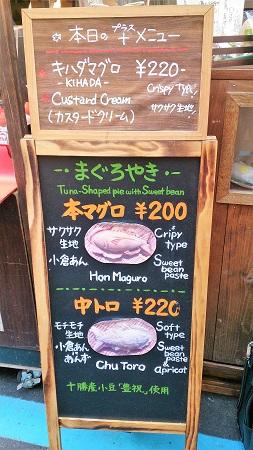
Kokura Ann's "hon tuna" and Kokura Ann's sweet and sour
Two kinds of "Nakatoro" wrapped with apricot.
You can only eat here
How about using "tuna grilled" as a snack or souvenir?
◆Tsukiji Sanokiya
Outside Tsukiji Market 4-11-9 Tsukiji, Chuo-ku, Tokyo
[Dimini ☆ Cricket]
June 17, 2018 18:00
At the special gallery space of the Chuo Ward Local Tenmonkan (Time Dome Akashi), located on the 6th floor of a complex such as the Chuo-ku Public Health Center facing St. Luke Street, 12-1 Akashicho, a special exhibition "Rediscovered Bunjin Exhibition related to  Chuo-ku" is being held. Chuo-ku" is being held.
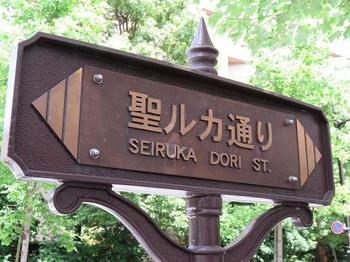
The event will be held from Saturday, May 26 to July 1 (Sun).
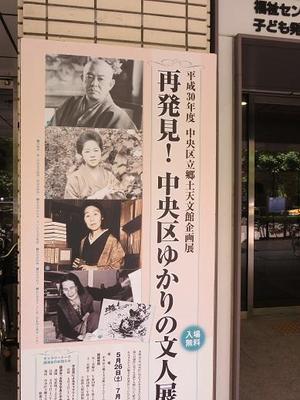
Open from 10 am to 7 pm Tuesday to Friday.
Saturday and Sunday are from ten a.m. to five p.m.
Admission is until 30 minutes before closing.
Monday is closed.
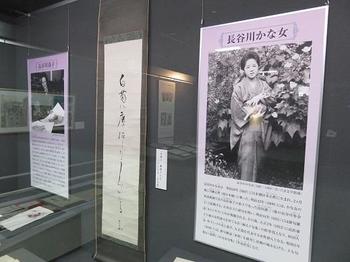
The literary artists featured are Junichirou Tanizaki, Shigure Hasegawa, Kanajo Hasegawa, Takeko Kujo, and Haruko Hasegawa, a publishing company located in Nihonbashikakigaracho, and a corner of Rokuko Publishing.
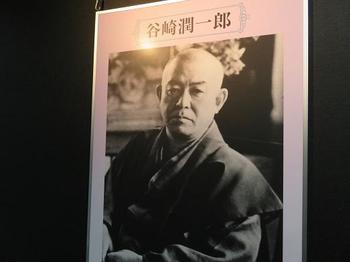
Junichirou Tanizaki was born at 2-chome Kakigaracho, Nihonbashi-ku (currently 1-chome, Nihonbashi Ningyocho, Chuo-ku). was born at 2-chome Kakigaracho, Nihonbashi-ku (currently 1-chome, Nihonbashi Ningyocho, Chuo-ku).
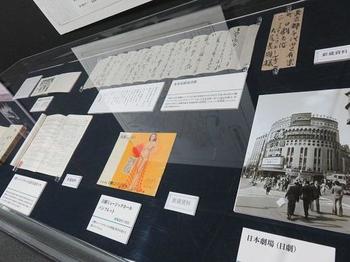
He is one of the most famous novelists in modern Japanese literature.
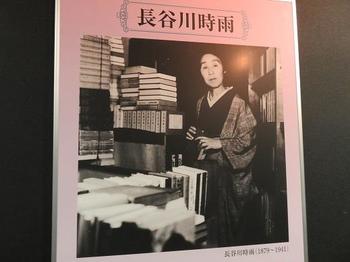
Shigure Hasegawa  was born at 1-chome, Toyucho, Nihonbashi-ku (currently 3-chome, Nihonbashi-Daidenmacho, Chuo-ku). was born at 1-chome, Toyucho, Nihonbashi-ku (currently 3-chome, Nihonbashi-Daidenmacho, Chuo-ku).
Playwright and novelist
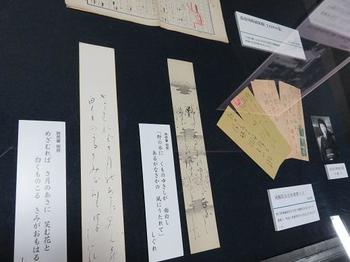
We published magazines and newspapers to improve the status of women.
His memoir "Old Mon Nihonbashi" is famous. 
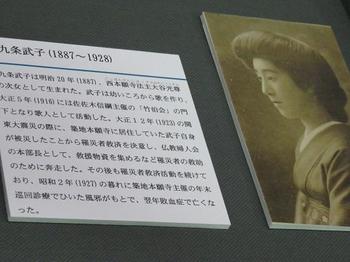
Takeko Kujo  is an educator and poet. is an educator and poet.
They helped rebuild Tsukiji Honganji Temple, which was completely destroyed by the Great Kanto Earthquake, and helped rescue injured person orphans in the wake of the earthquake. 
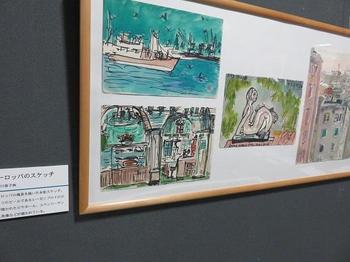
Haruko Hasegawa  is the younger sister of Shigure Hasegawa and a Western painter. is the younger sister of Shigure Hasegawa and a Western painter.
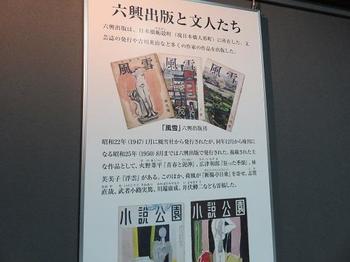
In the corner of Rokuko Publishing, handwritten manuscripts such as Fumiko Hayashi, Minoru Mushakoji, and Saisei Muro, who wrote in the company's magazine, were displayed. of Rokuko Publishing, handwritten manuscripts such as Fumiko Hayashi, Minoru Mushakoji, and Saisei Muro, who wrote in the company's magazine, were displayed.
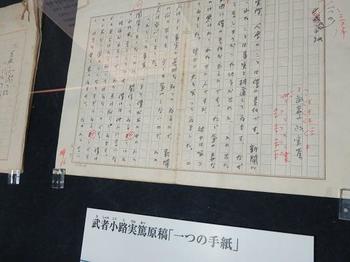
  The handwritten manuscript was real, such as the traces of the writer's elaborate work, and it was interesting to understand that it was such an expression at first. The handwritten manuscript was real, such as the traces of the writer's elaborate work, and it was interesting to understand that it was such an expression at first.
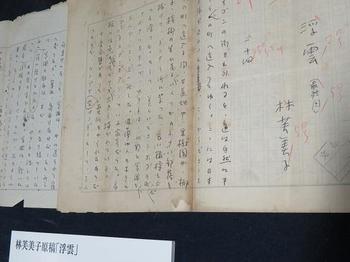
In addition, we received special consent from the venue where photography is prohibited.
Thank you very much
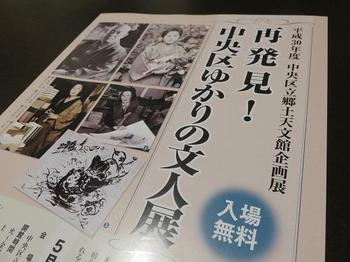
     
[Dharma]
June 15, 2018 12:00
"Sanno Festival"...It is one of the three major festivals in Japan, along with the Gion Festival in Kyoto and the Tenjin Festival in Osaka. The 2018 event schedule is from June 7 to 17 (see the Sanno Festival official website!) 。 On June 8, the largest ceremony of the Sanno Festival, "Kamiko Festival", was held. 2 Goho, 1 Miya portable shrine, Shinto priesthood, Miko, shrine parishioner, Saru Tabiko, Carriage, gohei, Kasahoko float, Lion, Nobori, Higher Lantern...They traveled around the shrine parishioner area in a large line of 300m. It is a reproduction of the dynasty picture scroll. 7; 30 Head Office - 12:00 Imperial Palace Sakashitamon (Sanga) - 13:20 Hie-jinja Shrine Nihonbashi auxiliary shrine....In front of main hall, three Gohoren and Miya portable shrine were lined up, and the grounds were filled with no cones, including Shinto priesthood Ujiko, the press and visitors. A pilgrimage horse is taking a break on the sidewalk behind the auxiliary shrine...From here, Kyobashi-Ginza-Shimbashi-in front of the Prime Minister's Office-16:45 It will be a pilgrimage to return to Ee Shrine.
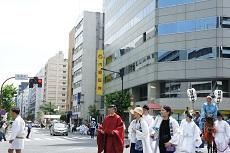 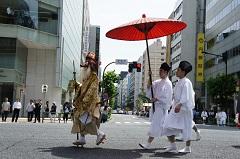
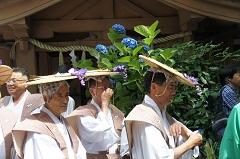 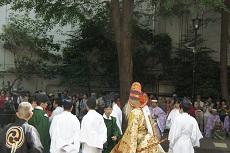
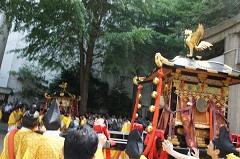 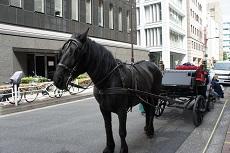
[Minato kid]
June 13, 2018 12:00
There is Shiomi guardian of children and travelers along the Sumida River at Minato 3-chome.
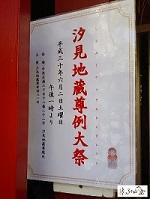 Located in one corner of Minatomachi Daiichi Children's Amusement Park, a small vermilion hall of about 4 tatami mats is a private house-style building with tin on the side. Surrounded by freshly overflowing potted plants, it is always kept clean. Located in one corner of Minatomachi Daiichi Children's Amusement Park, a small vermilion hall of about 4 tatami mats is a private house-style building with tin on the side. Surrounded by freshly overflowing potted plants, it is always kept clean.
On June 2, 2018, the Shiomi guardian of children and travelers memorial service was held.
There is a legend in this guardian of children and travelers.
Meiji period, a strange phenomenon occurred in this area, such as a voice saying "I want to get out of the water." So, when I dredged the bottom of the river, a single stone statue appeared.
At the same time, many human bones, teeth, and bones came out. The human bones were buried in the Kaikoin of both countries, and the teeth and bones were buried in this area along with stone statues and memorialized.
The stone statue stands on a pedestal with a height of about 55 cm and a height of about 70 cm, and it seems that teeth and bones are stored in this pedestal. The stone statue cannot be seen from the outside.
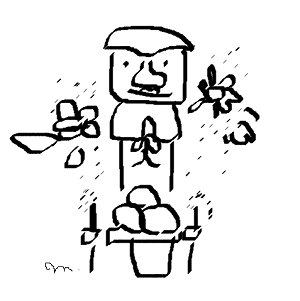 The history of Domae states that a large number of casualties were caused by the collapse of the Eitai Bridge on the day of the Tomioka Hachimangu Shrine Festival in 1807 (1807), the Great Fire, major earthquake, and the plague that struck Edo. The history of Domae states that a large number of casualties were caused by the collapse of the Eitai Bridge on the day of the Tomioka Hachimangu Shrine Festival in 1807 (1807), the Great Fire, major earthquake, and the plague that struck Edo.
The reason why the teeth and bones of the victims came out of this point due to these disasters may be due to the shape of the Sumida River.
It is a Jizo-son with requiem and prayer for people.
In order to protect the stone statue, it is a concrete guardian of children and travelers that was built in 1930 with a height of 95 cm. This is also a very rare work. On the back, it is written as "Shiomi Jizoson 3,300,303 people, Funamatsucho Mori Jizo". Funamatsumachi is the current location of guardian of children and travelers Shiomi, Minato 3-chome.
The history continues like this.
"If a person with a tooth sick takes the salt in front of the shrine and soaks the mouth, the pain will be cured, and thanks to the practice of offering salt and toothpicks, we are collecting a great religion as a guardian of children and travelers."
Shiomi guardian of children and travelers is widely worshiped as the god of teeth.
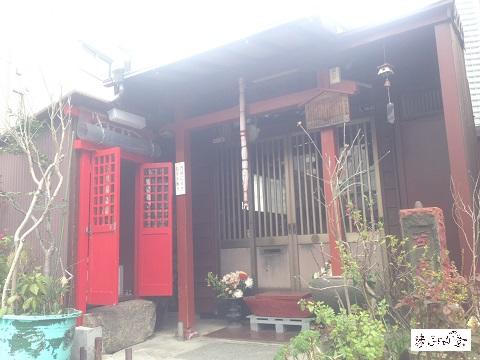 In addition, this area was Minatomachi, which was reclaimed after the great fire of the Meiryaku era. As the center of Edo Minato, it has a history of gathering supplies from various countries here. Edo Minato, where many ships are anchored, is also depicted at Edo famous places such as Edo famous places. In addition, this area was Minatomachi, which was reclaimed after the great fire of the Meiryaku era. As the center of Edo Minato, it has a history of gathering supplies from various countries here. Edo Minato, where many ships are anchored, is also depicted at Edo famous places such as Edo famous places.
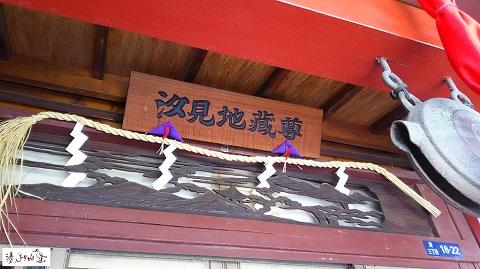 As a god overlooking Edo Minato, he was also watching the safety of water transportation. As evidence, guardian of children and travelers used to be enshrined toward the Sumida River. As a god overlooking Edo Minato, he was also watching the safety of water transportation. As evidence, guardian of children and travelers used to be enshrined toward the Sumida River.
The memorial service is held around June 6 every year.
Shiomi Jizo-son is carefully protected by the town council.
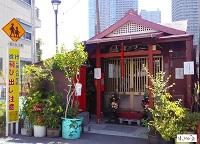
Shiomi guardian of children and travelers
3-18-22, Minato, Chuo-ku, Tokyo
※ It's back street, but there is a lot of traffic and everyone is speeding up. Please be careful when visiting the shrine.
Chuo-ku Tourism correspondent Minatokko-chan

No. 17 June 10, 2018
|
Links
|
![]()
![]()
![]()
![]()

![]()
![]()
![]()
![]()

![]()
![]()
![]()
![]()
![]()
![]()
![]()
![]()
![]()
![]()
![]()
![]()

![]()

![]()
![]()

![]()
























 Located in one corner of Minatomachi Daiichi Children's Amusement Park, a small vermilion hall of about 4 tatami mats is a private house-style building with tin on the side. Surrounded by freshly overflowing potted plants, it is always kept clean.
Located in one corner of Minatomachi Daiichi Children's Amusement Park, a small vermilion hall of about 4 tatami mats is a private house-style building with tin on the side. Surrounded by freshly overflowing potted plants, it is always kept clean. The history of Domae states that a large number of casualties were caused by the collapse of the Eitai Bridge on the day of the Tomioka Hachimangu Shrine Festival in 1807 (1807), the Great Fire, major earthquake, and the plague that struck Edo.
The history of Domae states that a large number of casualties were caused by the collapse of the Eitai Bridge on the day of the Tomioka Hachimangu Shrine Festival in 1807 (1807), the Great Fire, major earthquake, and the plague that struck Edo. In addition, this area was Minatomachi, which was reclaimed after the great fire of the Meiryaku era. As the center of Edo Minato, it has a history of gathering supplies from various countries here. Edo Minato, where many ships are anchored, is also depicted at Edo famous places such as Edo famous places.
In addition, this area was Minatomachi, which was reclaimed after the great fire of the Meiryaku era. As the center of Edo Minato, it has a history of gathering supplies from various countries here. Edo Minato, where many ships are anchored, is also depicted at Edo famous places such as Edo famous places.


